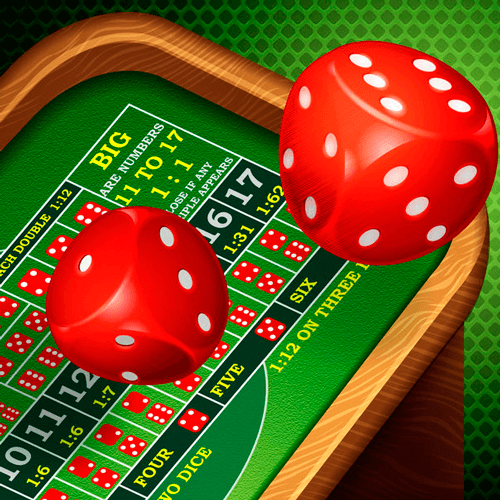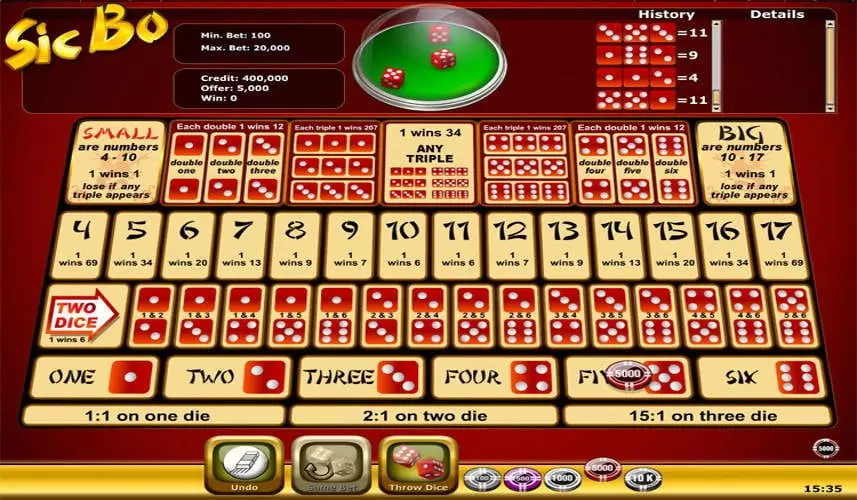
If a casino offers Sic Bo, it is very easy to identify. Unlike the surrounding European-style table games in the pit area, the Sic Bo table has no green or blue felt betting surface. Instead, it features a rather garish red, yellow, black and white rectangular betting area, usually made of translucent plastic or glass.

Bets are made by putting chips directly on the sections of the layout indicating the desired outcomes, rather like Roulette or Craps. These sections then light up from underneath to show all winning wagers. Players’ unused chips can be placed in grooves that appear in the wooden or leather railing on the perimeter of the table or else stacked on the unmarked felt apron around the betting field.
Blaze LED Surface Technology for Sicbo brings a new and exciting visual element to the popular game of Sicbo which is sure to excite and entertain players. Sic Bo is a simple dice game based on chance. All you need to do is place your chips on a bet box on the table. The dice are shaken and if the outcome of the roll matches your bet, you win. Sic Bo features a variety of possible bets, each with their own payout odds. Sic Bo is not a complicated game to master, but there are some rules that you should master, as the game moves at a lightning pace. Similarly to craps, Sic Bo is also played on a table specifically intended for it. Take a look at the image below to see the layout of a classic Sic Bo table. How a Round of Sic Bo is Played.

Other items that may be seen on the Sic Bo table include a placard showing the table limits, a rack for the Bank’s chips, three dice, and a Cage or Shaker. The dealer will rotate the dice in the Cage or use the Shaker’s spring trigger to mix up the dice and reveal the result—a process called the “spin.” Losing wagers will be collected from the unlit sections of the betting layout, and winners paid on the lit sections.

Sic Bo Betting Areas
The two far corners of the rectangular betting area are for the bets “Big” (to the players’ left) and “Small” (to the players’ right), from which the game’s alternative names are derived, Tai Sai and Dai Siu. There may be pictures of dragons and various Chinese ideograms appearing in these areas, too. In some European casinos, the corners may be marked “Gros” and “Petite,” and in the Philippines they are “High” and “Low.” No matter what language is used, the two sections are for making even-money wagers that the total of the three dice will be from 4 to 10 (Small) or from 11 to 17 (Big).
Sic Bo Tables In Las Vegas
Between the corners on the dealer’s side of the table are the areas for wagering on “doubles” and “triples.” They actually show the faces of the dice making up pairs or three of a kind, so there can be no mistaking their meaning. In the very middle of these is the area for wagering on “Any Triple,” displaying all six possible combinations together.
Betting Rows
A row of betting areas across the middle of the table shows the numbers 4 through 17. These sections are for making bets on the specific total that will come up. On some Sic Bo tables, these numbers are consecutive, from 4 on the left to 17 on the right, but on most tables the numbers descend, left to right, from 10 to 4 and then from 17 to 11. The reason for this is to group the total by their odds, so that the highest (60-to-1) are in the very center of the table and lowest (6-to-1) are toward the outside.
Another row of betting areas is for specific non-double combinations of two dice, starting on the left from 1-2, 1-3, 1-4, etc. to 4-6 and 5-6 on the right. Again, the faces of the dice making up the combinations are pictured so that there can be no misunderstanding. All of these pay out at 5-to-1.
Sic Bo Payout Table

Lastly, along the side of the layout away from the dealer and closest to the players, there is a row picturing the six single die possibilities, 1 through 6, from left to right. The European version spells them out, too—un, deux, trois, quatre, cinq, six. These pay 1-to-1 when the chosen number shows up on one of the three dice, 2-to-1 for appearing on two dice, and 3-to-1 for turning up on all three.